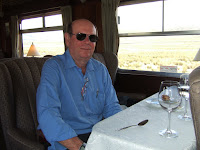
Travel Date 31st March 2010.
Please click on any picture to see the larger version.
A little dose of luxury can be therapeutic. After a week starting with the stress of flying Coolangatta – Sydney – Buenos Aires – Lima over two days, followed by jet-lag, traveller's curse, lumpy mattresses and noisy hostels I needed the Royal Inn Hotel in Puno followed by the Andean Explorer. I love travelling; I even enjoy many of the hassles despite that previous sentence. But we all need a touch of luxury sometimes.
I mourn the passing of the era of long-distance train travel. Yes, it usually takes longer, but it is so much more civilised than air travel. No long delays in airports, minimal security difficulties, lots of leg-room and the ability to wander around when you feel like it. Yeah, I know, I'm a dinosaur. There is also the different and more pleasurable, to me, form of sight-seeing; the vicarious pleasure of slowly gliding past people and communities getting on with their lives with scarcely an acknowledgement of us passing by.


The 4* hotel in Puno was serendipity as I mentioned earlier. I have no doubt that it helped me overcome my various combined travelling problems more quickly and I left Puno relaxed and refreshed as a result. The Andean Explorer was the icing on the cake. Sadly for Perurail, but luckily for the passengers, the train was less than half full.
The seats are arranged in pairs on one side of the aisle, mainly facing as tables of four, and as singles on the other side of the aisle. Some of the singles are arranged as facing pairs, some as single tables. The only glitch in the on-line booking system is a lack of ability to choose your seat. Thus, allocations were all over the place. Husbands and wives were separated, as were families. I was alone at a table for four, one family of four were seated in singles. Because of the reduced number of passengers the staff let us sort it out to our own convenience, but it could be a distinct difficulty when the train gets back to full operations.






Departing Puno we fairly quickly left the city and spent quite a while skirting the shores of Lake Titicaca. The second picture is the Yavari, the remaining one of two ships built in Britain at the request of the Peruvian Government in 1862 then disassembled, shipped in nearly 3,000 pieces to Peru and transferred by train and mules to the shores of the lake.
Various difficulties, including a war between Peru and Spain, delayed delivery and construction but she was finally launched with her sister-ship in 1870 and sailed Lake Titicaca for over a century before being laid off and falling into disrepair. She was re-discovered and renovated by a group of British-backed enthusiasts over the decade 1989-1999. See "1862: Vapor Yavari: Navigation on Lake Titicaca, Peru" for more detail.


The lake shore was dotted with small farms and occasional villages. Then, for no apparent reason, quite large structures would appear in the middle of nowhere. This is one example; it appears to be either an open-air church or one under construction. The nearest village took up less area than the church.


As we passed through Juliaca it became apparent that the local Quechua traders considered the train a darn nuisance. They barely stopped trading, with stalls within centimetres of the carriages. Items for sale were left between the tracks on the confident assumption that the train would clear them. In my youth the trains I travelled on in New South Wales had toilets which flushed on to the tracks; I hoped for the Quechua traders' sakes that was not the case on our train.


While boarding we were treated to music from this band at the station. Later they provided on-board entertainment with an extended performance in the observation car. After that a dancer joined them for her performance. After dinner she provided a fashion show, but I missed that.


We were served lunch about midday and later a small afternoon tea. Those were included in the ticket price of US$220, but food and drinks outside those times were extra. However, the prices were cheap; for example a "cafe Americain" was 8 soles or about $3. I chose the spinach cream soup and pork chops. They were delicious, although the chops resembled ribs more than chops. Serves were small but adequate and the wine glasses were well filled; my fellow "strangers on a train" were lovely people to spend a day with.


After Juliaca we picked up speed although we never at any stage travelled fast. The trip was slow and leisurely, partly because of the terrain but also because of the recent mudslides and need for caution.
Slowly the terrain changed from the flat plains of the lake shore to low hills and then we properly entered the Andes. The rails followed a river for most of the time, using the level floodplain to avoid the higher slopes. The scenery was simply spectacular.


The river became narrower and then disappeared as we reached Raya, the highest point on the line at 4319 meters or 14172 feet. Just before that we met our complementary train from Cusco to Puno, so here we are looking at each other.


Then we started to follow another little creek which became a river all the way to Cusco.




That river widened and grew stronger and rougher until we started to see some of the reasons why the line was closed for a month after the January mud-slides. Even now, the force and turbulence of this river, and the other high altitude Peruvian rivers I encountered, is difficult to convey.


We finally arrived in Cusco after dark, at about 7pm. A trifle late but I didn't care after one of the most pleasant and enjoyable days of my trip so far.
Cheers, Alan

No comments:
Post a Comment